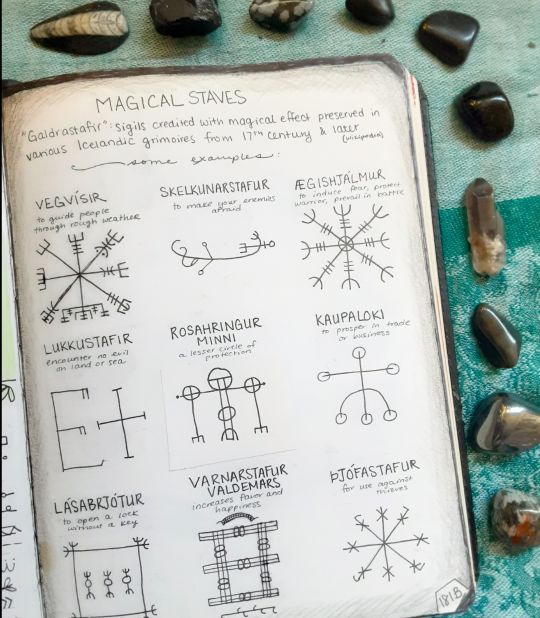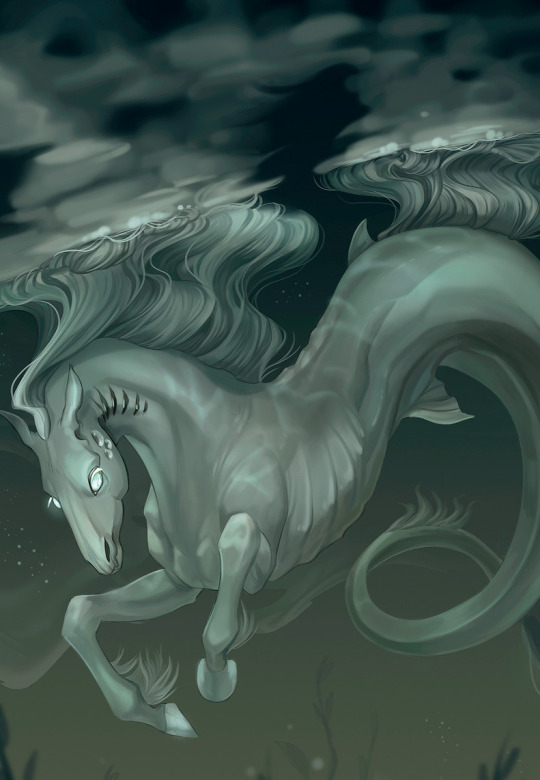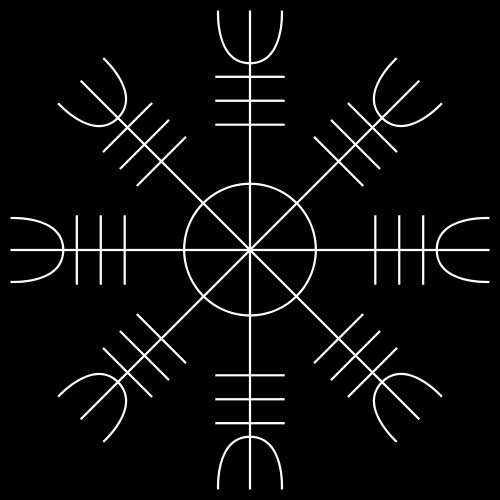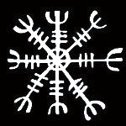#icelandic grimoire
Text

154 notes
·
View notes
Text
instagram
#romanjeunesse#roman#bookstagram#instalivre#magie#romanfantastique#laura hollingsworth#grimoire#dragon#islande#iceland#mountains#Instagram
0 notes
Text




The Evermore Grimoire: Celtic Mythology
A kelpie is a water horse spirit that inhabits lochs in Celtic mythology. It is described to look like a horse, but can also take on a human form and is believed to take delight in drowning its victims. In certain stories, it loves the human liver. One of the water-kelpie's common identifying characteristics is that its hooves are reversed as compared to those of a normal horse, a trait also shared by the Nykur of Scandinavian and Icelandic mythology. The creature's nature is either useful, hurtful, or seeking human companionship; in some cases, kelpies take their victims into the water, devour them, and throw the entrails to the water's edge. In its equine form the kelpie is able to extend the length of its back to carry many riders together into the depths; a common theme in the tales is of several children clambering onto the creature's back while one remains on the shore. Usually a little boy, he then pets the horse but his hand sticks to its neck. In some variations the boy cuts off his fingers or hand to free himself; he survives but the other children are carried off and drowned, with only some of their entrails being found later.
artwork by Helmiruusu
673 notes
·
View notes
Text
Y'know, I might post some of my grimoire's pages. I used to be very wary of it cause it's a personal book and all, but thinking about it I don't think it's bad to do on strictly informative pages.
So here's the runes I've written about so far🙏 I'm doing around one a day




I use the icelandic poems and I translate them myself, which for Úr I didn't even do completely cause I still don't know what "Umbre" is (shadows, with æ as e because medieval latin? Something else? Idk)
And ofc I like drawing so I've been doing little sketches for almost every page. I graduated art school so I might as well use my degree for something
So yeah enjoy! I may post more in the future
#actually plural#pluralgang#witchcraft#witchblr#norse runes#norse heathen#norse paganism#bookbinding#book of shadows#grimoire
9 notes
·
View notes
Text
Klaroline WIP Wed - Freaky Friday Time Travel AU - Klaus is a Master Baiter
It's been a while since put some of this out but i've been working on my plot issues and writing so here is some FFTT! as always @galvanizedfriend your tag!
Part One here
Part Two here
Part Three here
Part Four here
Part Five here
Pulling down a pink jacket, she wondered as she slipped it on if she’d be breaking any time laws if she brought it home with her. Shoes on, she went in search of Klaus.
The bedroom opened on a hallway lined with paintings with two closed doors and a staircase at the end, which curved around down to the landing. A living room was through one doorway, a kitchen and dining room through another. Klaus’ voice, sharp in tone, came from behind a door to the left that was cracked a smidge, and she padded quietly to the door to listen.
She needn’t have bothered, first off, he was speaking a language she wasn’t familiar with, and secondly, the moment she got within range of the door, he called out to her. “Caroline, do come in, love.”
Only slightly annoyed, she pushed the door open. The room was some kind of study or office, with a desk in the middle of the room and a couch over by the window and a corner fireplace, currently lit and casting patterns of light on the built-ins filled with books and small trinkets. A tumbler of some amber liquid in one hand, Klaus gave her a small smile, a phone held to one ear. It sounded like he was speaking maybe Icelandic or oh! probably Old Norse. She caught Kol's name flung out with irritation before he switched to English.
“I aim to enjoy time with my wife after that mess with the ifrit in Tehran that you elected not to join us for.” Klaus gestured to her to make herself comfortable, and trying not to think about how many times her future self had probably fucked Klaus on it, she sat down on the couch. Really tried not to think about it.
Looking at the firelight playing across Klaus' body, the jumble of necklaces tumbling over the neck of his shirt, Caroline very privately had to guess it was a lot of times for the couch. 'Stop that,' she told herself, 'You're with Tyler, and none of this has happened yet. You could make it all not happen.'
Kol's voice, heard by Caroline only once or twice before this, came through the phone clear to her hearing. "I knew you had it in hand, Nik. What's one teeny little fire spirit to the Original Hybrid?" His tone was mocking of Klaus' self-aggrandized title, and Caroline had to admit she was starting to see a future where maybe they could be friends, she and this nutjob brother of Klaus'.
"I don't suppose any of the Bennett witch's books happened to mention they're eight feet tall? Hmm?“ Klaus' voice was the epitome of murderous intent; he calmly took a drink, the corner of his mouth curling mischievously into a dimple that spoke volumes about how much he was enjoying leading his brother on.
”Uh. Eight feet? Really, they uh. Made them seem kind of... tiny.” Kol finished lamely. “We're at the Greek house for the month, don't have all the grimoires, you see.”
“So you've mentioned. I'll be sure to inform Caroline of your incompetence, little brother.”
“Caroline?” Kol's voice turned a little sharp. “She's okay, right? Nothing... happened?”
“Caroline's fine.” Klaus' voice was terrible and final, and for once Caroline thought he was speaking from the heart, like he was saying she would be fine because he willed it so.
“Nik, now just—”
“Like I said.” Klaus did a good impression of gathering himself. “I'd like to indulge in my wife without the family making a nuisance of themselves. Stay out of Brazil for the next month if you know what's good for you.” He hung up the phone.
“We're going to Brazil?” Caroline asked. She wasn't sure if that was a good thing or not. The part of her that desperately wanted to see the world was thrilled. The other part of her that was already freaking out from being in Paris didn't know if going to a second location was a good idea.
Klaus smiled. “No, we're going to the library. Kol is going to Brazil.” Beckoning with one hand, he pulled her to her feet. Pinching the edge of the fabric between two fingers, he gave her jacket a small tug. “Excellent choice, will blend you in nicely, and you look lovely.”
Caroline beamed at him, and he licked his lips, sighed almost regretfully, and then turned away, draining his glass and setting it on the desk. Tapping a touchscreen in the corner of it, the fire went out, and Klaus waved at her to follow him. Feeling a little off-kilter, she did.
#klaroline wip wed#klaroline#klaroline for ts#tvd for ts#listen#i cannot be held responsible for that title#it was RIGHT THERE#what was i supposed to DO?#not go there???#have you met me????
26 notes
·
View notes
Text
Germanic Paganism Sources
I can’t list these sources without first going through a million different caveats. I’m going to keep this introduction brief due to the length of this post, but be aware that these sources have been subjected to Christianization, speculation, mistranslation, etc. Many of these sources were copied down by Christian authors who may have altered the truth in order to fit their perspective. Some may have vague terms or phrases that we can no longer understand because they existed in an entirely new context. Essentially, approach all of these texts from a speculative and critical lens. This doesn’t mean we can’t decipher the truth. We can decipher the truth by comparing texts from the same time, countries, etc with each other and finding the common threads. Pairing these attestations with archaeological records is also immensely helpful and I hope to compile a list of archaeological records some time in the future. You can find many free records and studies by simply typing, for example, “anglo-saxon burials archaeological excavations.”
This list consists of records of various Germanic peoples, histories, as well as semi-legendary sagas and poetry. By exploring a variety of texts instead of just ethnographic works, we can understand the history, culture, customs, traditions, values, and more. These are all crucial in approaching paganism with the goal of accurate and thorough understanding. I wanted to focus primarily on sources from close to the pagan period, but I have also included current sources in the grimoires and runes section. For the contemporary study of Germanic paganism, I always recommend Stephen Flowers!
Happy researching
The Eddas
https://www.norron-mytologi.info/diverse/ThorpeThePoeticEdda.pdf
http://vsnrweb-publications.org.uk/EDDArestr.pdf
England
https://www.gutenberg.org/cache/epub/657/pg657-images.html
https://ia804700.us.archive.org/31/items/exeterbookanthol00goll/exeterbookanthol00goll.pdf
https://langeslag.uni-goettingen.de/oddities/texts/Aecerbot.pdf
https://www.documentacatholicaomnia.eu/03d/0627-0735,_Beda_Venerabilis,_Ecclesiastical_History_Of_England,_EN.pdf
https://www.ragweedforge.com/rpae.html (this website also has the norwegian and icelandic rune poems)
https://www.dvusd.org/cms/lib/AZ01901092/Centricity/Domain/2897/beowulf_heaney.pdf
https://sacred-texts.com/neu/ascp/
https://ia601403.us.archive.org/12/items/bede-the-reckoning-of-time-2012/Bede%20-%20The%20Reckoning%20of%20Time%20%282012%29.pdf
Germany
https://sacred-texts.com/neu/nblng/index.htm
https://www.germanicmythology.com/works/merseburgcharms.html
Frisia
https://www.liturgies.net/saints/willibrord/alcuin.htm
Denmark
https://sacred-texts.com/neu/saxo/index.htm
Iceland
https://archive.org/details/booksettlementi00ellwgoog/page/n4/mode/2up
Finland
https://sacred-texts.com/neu/kveng/kvrune01.htm
Germania
https://www.gutenberg.org/files/7524/7524-h/7524-h.htm
The Sagas
https://www.gutenberg.org/files/598/598-h/598-h.htm
http://vsnrweb-publications.org.uk/Heimskringla%20II.pdf
https://sacred-texts.com/neu/heim/05hakon.htm
https://sacred-texts.com/neu/vlsng/index.htm
https://sacred-texts.com/neu/egil/index.htm
https://sacred-texts.com/neu/ice/is3/index.htm
https://sagadb.org/files/pdf/eyrbyggja_saga.en.pdf
https://sagadb.org/brennu-njals_saga.en
Grimoires
https://archive.org/details/GaldrabokAnIcelandicGrimoire1
https://handrit.is/manuscript/view/is/IB04-0383/9#page/3v/mode/2up
https://galdrastafir.com/#vegvisir
Runes
https://www.esonet.org/wp-content/uploads/2010/04/Futhark-A-Handbook-of-Rune-Magic-Edred-Thorsson-1984.pdf
*Due to link limits on tumblr, i cannot link all of these. Please paste them into your browser.
*Also, sadly I could not find some of the sources I wanted for free. I will continue to update this post with new links and it will be pinned to my profile always!
14 notes
·
View notes
Note
Hey I was wondering if you had any resources to share related to familiars and magical books. I remember reading somewhere about witches' familiars being trapped in books, not the book's spirit per se but rather a different spirit living in the book or working from the book, something like that? Any and all recommended reading is appreciated
Ohh that's a tricky one. Sorry for the extreme delay. I kinda forgot tumblr existed for like a year or so and your ask was buried under some much less friendly anon messages and I uhhh procrastinate pretty hard with the ask box in that state due to The Horrors.
anyway:
As far as a spirit that lives in a book, traditional american witchlore holds that a familiar spirit may take up residence in almost anything, a book included, that the calling witch desires. It could be you found a reference to this.
In the black book tradition of icelandic countries, specifically, magical books are believed to possess a kind of discrete power of their own, (this is echoed somewhat in american witch lore, but with fewer stipulations) that the magician avails themselves of by hand-copying the entire book to make up their own copy.
in that tradition It's said such books are to be hand copied verbatim, lest the spells lose their effectiveness for the magician who copies one incorrectly, or makes corrections not specified within the text.
There are many of these books now within the public domain, and some contain spells ranging the gamut from making people fart in church to killing ones enemy to making gold. Absolutely one of my favorite currents to read from because of the sheer variety and scope of methods they mention, though, consistent with this tradition is a tendency for spells to contain very specific and often complex instructions, some of which would be quite difficult to replicate faithfully. That said, one text dealing with this tradition of texts that I found just the other night, The Black Books of Elverum by Mary Rustad, is located here: https://archive.org/details/the-black-books-of-elverum
^^that one has a pdf available as well as plaintext, and the plaintext conversion is really quite good, comparatively, and would require very little preprocessing to parse digitally, if you're of that bent.
As I said, many of these books have been translated and are now within the public domain, but if you're after a compendium of works I very much enjoy the Svartkonstbocker, which is a compendium of swedish black book materials by Dr Thomas K. Johnson. I possess a physical copy and don't believe this particular text is within the public domain, but if you're in the market for hard texts, I've found it worth the price of admission.
To switch gears and discuss texts more aligned to my own leanings, a book I often eat in one sitting every couple years when the power goes out that details calling familiar spirits Is Folk Witchcraft by Roger J. Horne. I recommend it fairly frequently, It's a pleasant read, the font could be larger, but it's far from the worst beginner text on spirit work I've ever read.
It contains numerous primers and several spells and orations dealing with the attraction of a familiar spirit. This could be a decent place to look.
If you're looking for something in the grimoire tradition, there's the grimorium verum, which insists that a pact with a spheres ruling spirit must be performed to make the related spells within their spheres function. A pdf edition is available here:
https://nekropolis.dk/wp-content/uploads/2020/09/GrimoriumVerum.pdf
Not my wheelhouse, nor my religion, but it does contain instructions for the creation of numerous tools and a fair few pages of interesting workings, though it is more or less a text concerned primarily with daemons and the pacting therewith.
If you think the reference you found may have been pointing to the grimoire tradition, or if the solomonic tradition is your get, Secrets of Solomon by Joseph Peterson is an interesting read, quite dense for its page count and deals primarily with translation of "the little key of solomon concerning the secrets"; It again is concerned primarily with the ritual conjuring of spirits and the working of solomonic magic, and contains instructions, seals, and conjurations for everything from planetary intelligences to cthonic spirits. I don't believe this particular text is within the public domain, but earlier translations of both the lesser and greater keys of solomon are very easy to find online, should you feel either of these are likely to be the book you had reference to.
Honorable mention for a text that is also not public domain yet, but is dense for its page count and contains several discrete tables concerning different classes of spirits and their attending seals and conjuration information would be The Complete Book of Magic and Witchcraft by Kathryn Paulsen, if only for the extremely 2edgy4u darkness dementia raven way Satanic Panic aesthetic and also the excellent bibliography. My memory is shit, but I believe I must have recommended this one before, and if I haven't shame for me, if only for the sheer amount of information on materia magica it contains.
it also contains references from a number of texts, themselves now within the public domain, including Reginald Scotts The Discoverie Of Witchcraft, to the keys of solomon, to The Book of Secrets of Albertus Magnus. All of which are pretty fun reads.
I kinda doubt I've answered your question as you'd hoped, as I'm honestly drawing a blank for your precise ask, but any one of these texts is a good and fun place to start if you've still not found what you were looking for, book ghost wise.
38 notes
·
View notes
Text

On Vegvísir:
This one is a fun one and my personal favorite out of all the old and new Norse Pagan symbology.
This is the wayfarer's compass which was originally found in the late 19th century in the Huld Manuscript, yet, while it is far later than any original documentation, the sigil has been adopted readily into the new Norse Pagan movement.
Now, while this is younger than any other known sigil/magical stave, there's nothing to prove that it isn't from the correct times either. Too many texts on the matter have been lost.
What's a Stave/Sigil?
Icelandic magical staves (Icelandic: galdrastafir) are sigils that were credited with supposed magical effect preserved in various Icelandic grimoires, such as the Galdrabók, dating from the 17th century and later. Again, not to say that some aren't period accurate, a massive chunk of the Norse Sagas were lost over the centuries and those texts may have had these sigils in or may not have.
What's the meaning of Vegvísir?
Quite simply, "if this sign is carried, one will never lose one's way in storms or bad weather, even when the way is not known." I, personally, have heard this sigil to be either Christian or not Christian. It's unknown. (Some also attribute "bad weather" to be going through rough times in life and needing to find a way forward.)
Another take on Vegvísir is that it depicts a map of sorts of the nine realms with Midgard in the middle, the same application of guiding one's way otherwise.
Another sigil/stave of dubious origin is the Helm of Awe/Ægishjálmur, which, while mentioned in the Eddas and other sagas, the depiction of it as it is shown today was made during the modern era (20th/21st centuries.)
3 notes
·
View notes
Text
surprisingly effective conversation in a viking-themed facebook group correcting someones assertion that the early modern icelandic grimoires were judeochristian (as opposed to just christian lol) at least the guy was willing to listen and correct himself. rare
5 notes
·
View notes
Text
THE HELM OF AWE

Such overpowering might was apparently what this magical symbol was intended to produce. In the Fáfnismál, one of the poems in the Poetic Edda, the havoc-wreaking dragon Fafnir attributes much of his apparent invincibility to his use of the Helm of Awe:
The Helm of Awe
I wore before the sons of men
In defense of my treasure;
Amongst all, I alone was strong,
I thought to myself,
For I found no power a match for my own.
This interpretation is confirmed by a spell called “There is a Simple Helm of Awe Working” in the collection of Icelandic folktales collected by the great Jón Árnason in the nineteenth century. The spell reads:
Make a helm of awe in lead, press the lead sign between the eyebrows, and speak the formula:
Ægishjálm er ég ber
milli brúna mér!
I bear the helm of awe
between my brows!
Thus a man could meet his enemies and be sure of victory.
Like most ancient Germanic symbols, the form of its visual representation was far from strictly fixed. For example, the 41st spell in the Galdrabók, a seventeenth-century Icelandic grimoire, includes a drawing of the Helm of Awe with only four arms and without the sets of lines that run perpendicular to the arms.
Linguist and runologist Stephen Flowers notes that even though the references to the Helm of Awe in the Poetic Edda describe it as a physical thing charged with magical properties, the original meaning of the Old Norse hjálmr was “covering.” He goes on to theorize that:
This helm of awe was originally a kind of sphere of magical power to strike fear into the enemy. It was associated with the power of serpents to paralyze their prey before striking (hence, the connection with Fáfnir). … The helm of awe as described in the manuscript [the Galdrabók] is a power, centered in the pineal gland and emanating from it and the eyes. [In Aristotle and Neoplatonism, sources for much medieval magic, the spirit connects to the body via the pineal gland, and the eyes emit rays of spiritual power.] It is symbolized by a crosslike configuration, which in its simplest form is made up of what appear to be either four younger M-runes or older Z-runes. These figures can, however, become very complex.
The connection with the runes is particularly apt, because a number of the shapes that comprise the Helm of Awe have the same forms as certain runes. Given the centrality of the runes in Germanic magic as a whole, this correspondence is highly unlikely to have been coincidental.
The “arms” of the Helm appear to be Z-runes. The original name of this rune is unknown, but nowadays it’s often called “Algiz.” The meaning of this rune had much to do with protection and prevailing over one’s enemies, which makes it a fitting choice for inclusion in a symbol like the Helm of Awe.
The “spikes” that run perpendicular to the “arms” could be Isa runes. While the meaning of this rune is more or less unknown due to the confusing and contradictory information supplied by the primary sources, it seems reasonable to speculate that, since “Isa” means “ice,” its inclusion in the Helm of Awe could have imparted to the symbol a sense of concentration and hardening, as well as a connection to the animating spirits of wintry cold and darkness, the fearsome giants. This connection is made more likely by the fact that the dragon Fafnir occupies a role in the tales of the human hero Sigurd analogous to that occupied by the giants in the tales of the gods. Such connections are necessarily speculations, especially since the markings that may or may not be Isa runes are, graphically speaking, nothing more than straight lines, which makes them that much harder to positively identify. Nevertheless, the tenacity of the connections here is quite striking.
#helmofawe#transcendence#witchcraft#magick#magic#god#norse religion#vikings#norse runes#old norse#norse mythology#aegishjalmr#magic symbols#runes#nordic#nordic runes
3 notes
·
View notes
Text
Of Galdrastafir and Cipher Runes
Galdrastafir – Icelandic Staves
Often conflated with bind runes the Icelandic magical staves are an hybrid outgrowth of the ancient runic alphabet being incorporated into the Icelandic grimoire tradition and the latin alphabet. These creations are creative expressions of magical spells and often appear upon amulets and within magical books. The runes themselves do not appear often or clearly,…

View On WordPress
#Ægishjálmur#Cipher Runes#Draumstafir#Galdrastafir#helm of awe#Helm of Disguise#Help of terror#Hulinhjalmur#lønnruner#Runes#Vegvísir#Wayfinder
0 notes
Text
You can summon money using a stolen coin, an ancient symbol drawn on the skin of a black cat, using a sea mouse and the menstrual blood of a maiden. All these things together will...
0 notes
Note
Sorry, I forgot to add the context that the spell was from an icelandic grimoir.
Jokes on you I’m already cursed
0 notes
Text
Protection sigil norse

#Protection sigil norse how to#
The connection with the runes is particularly apt, because a number of the shapes that comprise the Helm of Awe have the same forms as certain runes. These figures can, however, become very complex. It is symbolized by a crosslike configuration, which in its simplest form is made up of what appear to be either four younger M-runes or older Z-runes. … The helm of awe as described in the manuscript is a power, centered in the pineal gland and emanating from it and the eyes. It was associated with the power of serpents to paralyze their prey before striking (hence, the connection with Fáfnir). This helm of awe was originally a kind of sphere of magical power to strike fear into the enemy. Linguist and runologist Stephen Flowers notes that even though the references to the Helm of Awe in the Poetic Edda describe it as a physical thing charged with magical properties, the original meaning of the Old Norse hjálmr was “covering.” He goes on to theorize that: For example, the 41st spell in the Galdrabók, a seventeenth-century Icelandic grimoire, includes a drawing of the Helm of Awe with only four arms and without the sets of lines that run perpendicular to the arms. Like most ancient Germanic symbols, the form of its visual representation was far from strictly fixed. Thus a man could meet his enemies and be sure of victory. Make a helm of awe in lead, press the lead sign between the eyebrows, and speak the formula: This interpretation is confirmed by a spell called “There is a Simple Helm of Awe Working” in the collection of Icelandic folktales collected by the great Jón Árnason in the nineteenth century. One of the representations of the Ægishjálmr in the Galdrabók In the Fáfnismál, one of the poems in the Poetic Edda, the havoc-wreaking dragon Fafnir attributes much of his apparent invincibility to his use of the Helm of Awe:įor I found no power a match for my own. Such overpowering might was apparently what this magical symbol was intended to produce. Just looking at its form, without any prior knowledge of what that form symbolizes, is enough to inspire awe and fear: eight arms that look like spiked tridents radiate out from a central point, as if defending that central point by going on the offensive against any and all hostile forces that surround it. The Helm of Awe ( Old Norse Ægishjálmr, pronounced “EYE-gis-hiowlm-er”) is one of the most mysterious and powerful symbols in Norse mythology. Book Review: Neil Price’s The Viking Way: Magic and Mind in Late Iron Age Scandinavia.Who Were the Indo-Europeans and Why Do They Matter?.The Swastika – Its Ancient Origins and Modern (Mis)use.
#Protection sigil norse how to#
The Old Norse Language and How to Learn It.The 10 Best Advanced Norse Mythology Books.The Vikings’ Conversion to Christianity.

0 notes
Text

Sorry mais c’était trop drôle pour ne pas le partager x’D
#lol#witchblr#witchy memes#occult books#old grimoire#icelandic grimoire#galdrabok#galdrabok spell#old spell#old curse#curse#hex#curse of very great farting#funny curse#malédiction#sigil#sigil magic
5 notes
·
View notes
Text
youtube
Similarities Between Icelandic Magic Staves and Umbanda Symbols
#symbols#semiotics#sigils#language#magic#magick#grimoire#Icelandic Magic#umbanda#art#philosophy#staves#esoteric#occult#hermeticism
266 notes
·
View notes